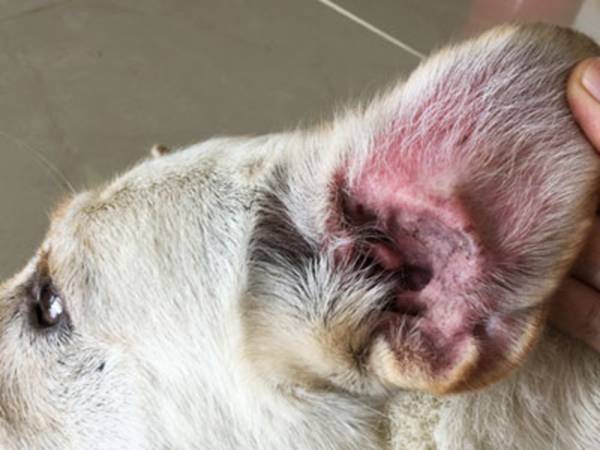X-rays, also called radiography, are a popular diagnostic tool used by human doctors and veterinarians. If your fur baby’s vet has ordered x-rays, it can be a bit scary. You may worry about the diagnosis, what will happen to your dog during an x-ray, and how much will it cost, etc. You may also worry about the radiation your pup will receive during an x-ray. We’ve done the research to help you learn about dog x-rays, what they can and can’t show, and more.
Connect with a verified veterinarian in minutes. Licensed vets are available 24/7 to answer your questions. No need to worry about your furry family member.
What are Dog X-Rays?
The term “x-rays” sounds like something out of a sci-fi thriller! However, they’re actually quite common. X-rays are a type of electromagnetic radiation that’s used to create images of the inside of humans and pets. These images, after development, come out in shades of gray, black and white. The tissues being x-rayed absorb radiation in different amounts, which leads to the shading differences. Bones absorb more x-rays than fat and soft tissues.
These images are often associated with broken bones; however, they can be used to diagnose other conditions, too. If you’ve had a chest x-ray, your doctor was looking for signs of lung disease or another condition. Mammograms are another common x-ray technique used to check for breast cancer. Veterinarians have been using x-rays to diagnose health issues in dogs for several decades. In fact, this is one of the most commonly used diagnostic imaging tool, as they’re less expensive than CT scans, MRIs and other types of imaging.
What Can Dog X-Rays Diagnose?
Dog x-rays are often used to check on a dog’s bone structure. Perhaps the vet suspects a broken bone or arthritis in a hip, etc. However, they’re used to check more than just bones. Diagnostic chest x-rays, in dogs, can help the vet to determine if your dog has some type of lung or heart disease. The vet will also use this tool if he suspects lung cancer or wants to see if cancer has spread in the body. Abdominal x-rays may be ordered by the vet if a dog is vomiting, is constipated or even has diarrhea. X-rays of the abdomen may also be taken if your dog may have swallowed something he shouldn’t have, or when other tests seem to show there may be a problem in the abdominal organs. A dog pregnancy x-ray can also be used to see if a dog is pregnant or not and to count the number of puppies she’ll have! Abdominal x-rays can also be used to diagnose problems with the kidneys, bladder and the reproductive organs.
A barium x ray for dogs is also sometimes necessary. For this test, your dog will need to swallow a substance called barium, which absorbs x-rays. Barium, once swallowed, shows up as white on an x-ray image. Your pup may get to “enjoy” a barium shake before his x-ray! Barium is sometimes used to diagnose stomach issues and problems with the GI tract. For a GI tract issue, a series of x-rays is taken about every 30 to 60 minutes. During this time, the images track the barium through the digestive tract.
These tests are used to diagnose many problems in dogs, including a stomach or intestinal blockage.

Review symptoms, medications & behavior to keep your pets healthy with a Vet Online in just minutes.
Ask a Vet Live NowWhat Are Dog X-Rays Not Good For?
X-rays do not help to diagnose issues such as ligament tears or bone bruises. Small tumors may sometimes blend in with other tissue and remain undetected. In addition, the images can’t show some obstructions in the throat or digestive system—for instance plastic parts of toys, etc.
For some issues, other types of imaging may be necessary. Sometimes the vet may choose to use an MRI or CT to detect certain issues with your fur baby’s brain, heart and other organs.
Dog X-Ray Process
X-rays are painless, so your dog won’t feel anything. They also generally only take about 10 minutes, unless the vet has ordered another type of x-ray image or needs to take several images. A glass plate will be laid across an x-ray table; the glass plate contains the film needed to make the image. Then your fur baby will be placed over the glass plate. The vet will position your canine companion so the area needing to be viewed will be directly over the glass plate.
The x-ray machine is usually on a type of mechanical arm, which makes it easy to maneuver the equipment over the area to be examined. During the x-ray, a dog must remain still and relaxed. Otherwise, a blurry image could result. A blurry image is not clear enough to make a diagnosis. If your pup isn’t happy with medical procedures, he may need to be gently sedated. However, a dog x ray without sedation is more common. After your dog is calm and still, the x-ray machine will make the necessary image. It’s sometimes necessary to reposition the dog, which makes it easier to get images from all angles. Your vet will ask you to leave the room when the x-rays are being done. This is to help your dog stay calm and also to keep you safe from unnecessary radiation exposure. The techs taking the x-rays will have protective aprons on to avoid exposure. So, don’t be alarmed when you’re asked to leave the room.
Once the x-ray is complete, your dog can then be allowed off the x-ray table. The vet will have the images processed. This usually takes about 30 minutes. Many times, you can also receive digital copies of your pup’s images.
A registered veterinary radiologist will read the x-ray images and let the vet know about the imaging results. This is much the same way it’s done for human x-rays.
Are Dog X-Rays Safe?
Yes, dog x-rays are generally safe. When a vet orders x-rays for your dog, the technician will use the lowest amount of radiation possible for the image. This helps to minimize your dog’s exposure and possible risks developing cancer at some point. It’s important to understand that we’re all bombarded with radiation every day. Radiation is found in dirt, materials used to build, air, water, and even comes from space. These are naturally occurring forms of radiation, called background radiation. The amount of radiation dogs (or their pet parents) receive during an x-ray is comparable to the amount received from daily exposure to background radiation.
The issue with x-rays is the cumulative exposure over time. The more radiation you and your dog are exposed to, there’s an increased risk that either of you could develop cancer at some later point. This is a small risk; however, the more radiation exposure, the higher the risk for cancer and even birth defects (in fetuses or unborn puppies). When a vet orders x-rays of a pregnant dog, they usually only do so after about 42 days into your dog’s pregnancy. This is because before this time, the bones of the puppies will not be hard and won’t show up on the images. However, after 42 days, the puppies’ bones will be hard enough to be clearly seen in an x-ray. Closer to the due date, an x-ray can even show how many puppies your dog is expecting. The vet counts the skulls seen in your dog’s abdominal image.
How Much Does A Dog X Ray Cost?
The cost of a dog x-ray will vary, just as the cost of human x-rays can vary. Cost variations occur with the location or region. For instance, x-rays may be cheaper in a larger metropolitan area, and higher in a rural area where there aren’t as many veterinarians. Other variables can include the size of the dog, if contrast or sedation are needed, etc. X-rays done at an emergency pet hospital or clinic will typically be more expensive than those at your regular vet’s office. Sedation will also increase the cost of your pet’s x-ray. In addition, some areas of the body are easier to x-ray than others. The cost can also increase depending on the number of images the vet needs to make a diagnosis.
The average cost of a dog x-ray can vary from $80 to $500, or more. If you have a financial issue that makes it difficult to pay for the procedure, be sure to reach out to your vet. Let them know what’s going on. Some vets offer payment plans or may have a sliding scale based on your family’s income. It doesn’t hurt to ask. Other options that may be a little cheaper can include going to a veterinary teaching hospital for treatment. Pet health insurance can also help when it comes to the cost of veterinary procedures.
Can I Take My Dog’s X-Rays Home?
Maybe. Many vets are willing to show you the images and talk with you about the x-ray results. And sometimes the vet needs to send the images to a specialist for further review. This is normal. When it comes to taking the images home, you may find that the vet has an extra charge to make copies for you.
Cheap Dog X Rays Near Me
There are some different options available to find inexpensive x-rays for your dog. As noted earlier, you might consider getting your pup treated at a veterinary school. You can also search for low-cost veterinary services in your area. Just do a Google search using the phrase above (the heading for this section)—put the phrase in the search box and then hit enter. Google will bring up a list and possibly a map of cheaper vets in your area. And don’t hesitate to talk with your vet if finances are tight. Many vets are willing to work with you on payment options. It never hurts to ask—all they can say is no. Also ask your vet if there are cheaper imaging services nearby. They may be able to help you in this way.
Dog x-rays can be an important tool in diagnosing many health issues in your fur baby. X-rays are generally safe and can help your vet make a definitive diagnosis of everything from broken bones to how many puppies your canine companion may be having! Don’t be afraid to ask about payment options if you have a tight budget. Many vets are willing to help you find less expensive treatments, even x-rays, so you can get your dog the help he needs.
Connect with a verified veterinarian in minutes. Licensed vets are available 24/7 to answer your questions. No need to worry about your furry family member.

Julie
Julie is a graduate of the University of North Carolina, Wilmington, where she studied Animal science. Though contrary to the opinion of her parents she was meant to study pharmacy, but she was in love with animals especially cats. Julie currently works in an animal research institute (NGO) in California and loves spending quality time with her little cat. She has the passion for making research about animals, how they survive, their way of life among others and publishes it. Julie is also happily married with two kids.
Review symptoms, medications & behavior to keep your pets healthy with a Vet Online in just minutes.
Ask a Vet Live Now



